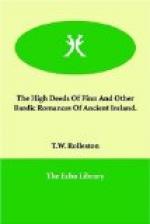These stories are but a few out of a great number of the loves and wars between the men and women of the human and the fairy races. Curiously enough, as the stories become less ancient, the relations between men and the fairies are more real, more close, even more affectionate. Finn and the Fianna seem to be almost in daily companionship with the fairy host—much nearer to them than the men of the Heroic Cycle are to the gods. They interchange love and music and battle and adventure with one another. They are, for the most part, excellent friends; and their intercourse suffers from no doubt. It is as real as the intercourse between Welsh and English on the Borderland.
There was nothing illusive, nothing merely imaginary, in these fairy worlds for the Irish hero or the Irish people. They believed the lands to be as real as their own, and the indwellers of fairyland to have like passions with themselves. Finn is not a bit surprised when Vivionn the giantess sits beside him on the hill, or Fergus when King Iubdan stands on his hand; or St Patrick when Ethne, out of fairyland, dies on his breast, or when he sees, at his spell, Cuchulain, dead some nine hundred years, come forth out of the dark gates of Sheol, high in his chariot, grasping his deadly spear, driven as of old by his well-loved charioteer, drawn by the immortal steeds through the mist, and finally talking of his deeds and claiming a place in the Christian heaven—a place that Patrick yields to him. The invisible worlds lived, loved, and thought around this visible world, and were, it seems, closer and more real to the Celtic than to other races.
But it was not only these agreeable and lovely folk in pleasant habitations whom the Irish made, but also spirits of another sort, of lesser powers and those chiefly malignant, having no fixed dwelling-place, homeless in the air and drifting with it, embodying the venomous and deadly elements of the earth and the angers and cruelty of the sea, and the hypocrisy of them all—demons, some of whom, like the stepmother of the children of Lir, have been changed from men or women because of wicked doings, but the most part born of the evil in Nature herself. They do what harm they can to innocent folk; they enter into, support, and direct—like Macbeth’s witches—the evil thoughts of men; they rejoice in the battle, in the wounds and pain and death of men; they shriek and scream and laugh around the head of the hero when he goes forth, like Cuchulain, to an unwearied slaughter of men. They make the blight, the deadly mist, the cruel tempest. To deceive is their pleasure; to discourage, to baffle, to ruin the hero is their happiness. Some of them are monsters of terrific aspect who abide in lakes or in desolate rocks, as the terrible tri-formed horse whom Fergus mac Leda conquered and by whom he died.




